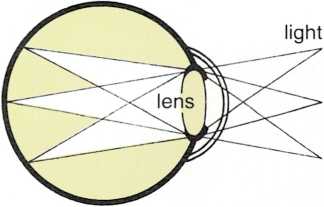

The lens in your eye bends light rays and makes them focus, or come
together, at the back of your eye.
Seeing it clearly
Your eyes don’t hurt, but the doctor says you need glasses. Why? How can
glasses help your eyes?
Light comes into your eye through the pupil—the round, dark opening in
the middle. Just behind the pupil is a built-in lens. The lens bends the
light and makes it fall on a spot called the retina [(reht]{.smallcaps}
uh nuh) that is at the back of the eye. The retina is full of nerves
that go to your brain. When light touches the retina, a message is sent
to your brain—and you see.
The lenses in your eyes are soft. They change shape, so that light rays
will come together, or focus, on the retina. Muscles in the eye squeeze
the lens and make it thicker for close-up seeing. For far-off seeing,
muscles pull the lens and make it thinner.
Sometimes people’s eyes are not quite the right shape. No squeezing or
pulling changes the lens enough to make the light rays focus on the
retina. Either nearby or faraway things look fuzzy.
When your eyes are tested, the doctor can tell exactly how much help
your lenses need. Then glasses are made with lenses that bend the light
rays just enough to make them focus on the retina.
